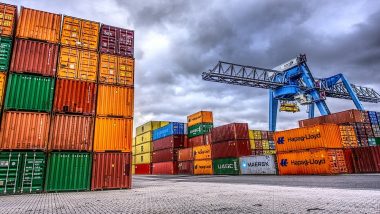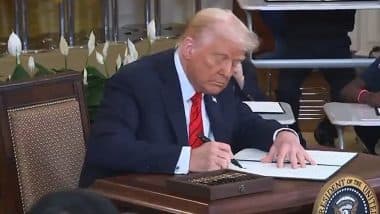Singapore, November 5: On Thursday last week, President Trump hinted that he was close to agreeing a trade deal with China after a phone call with President Xi. On Friday, Bloomberg reported unnamed sources in the White House saying the President had asked key officials to start work on a draft of a potential trade agreement with China. Stock markets were on the up and up.
This optimism did not last. Later the same day, White House economic adviser Larry Kudlow dampened expectations of a quick deal in a CNBC interview. The US stock market reacted negatively and ended a run of three consecutive days of gains.
The goal of forcing trade talks with China through tariffs is to reduce the trade deficit with China and establish fairer trading terms for US companies. However, the US government's other aim of bringing some manufacturing home may not be realistic. The reality is that production and distribution supply chains of products and their components are so integrally linked, it is more likely companies will find countries in Asia overall less costly to shift production to. Trade War: US-China Trade Talks Hit a Roadblock as Negotiations Between the Two Countries Halts Completely.
As the US trade dispute with China gained momentum earlier this year, analysts were putting forth suggestions about which countries would benefit most.
Countries like Taiwan, Thailand and Malaysia are luring more electronics and computer companies to their shores. Cambodia, Philippines and Bangladesh are seeking more opportunities to increase their market share in the production of apparel and footwear. Likewise, Thailand and Vietnam for household consumer goods like washing machines and refrigerators.
Indeed, in a study by American Chamber of Commerce South China (AmCham South China) published on October 29, where 219 companies were surveyed on the impact of US and China tariffs, less than one percent indicate any plans to relocate manufacturing to North America. In September, a joint study of 430 firms by AmCham China and AmCham Shanghai, found only 6 percent of respondents saying they may consider relocating production to the US.
The same report mentions that Southeast Asia and the Indian Subcontinent were the destination of choice should relocation occur. There are however some limitation to how much production can be moved out of China.
Through years of establishing China as "the world's factory", it has nurtured a highly trained, skilled and disciplined workforce.The infrastructure, roads, ports and integrated logistical support is second to none in terms of its ability to handle the volume of goods produced. This makes China an efficient and effective production centre. Furthermore, China's workforce is more than double that of all Southeast Asia combined. So, even if there are cost benefits of moving production out of China, there simply isn't enough capacity elsewhere to takeover what China can produced.
A study by India's Department of Commerce identified about 100 products where India can replace US exports to China due to higher import tariffs imposed by China on US farm products. These include corn, grain sorghum, oranges, cotton, almonds and durum wheat.
Another report by the Confederation of Indian Industry (CII) concluded that with concerted effort, India can increase its exports of products like pumps, parts of taps, parts for the defence and aerospace industry, vehicles, automobile parts and engineering goods among others.
India if it plays its cards right, might even be a major part of the re-shaped global supply chain. At the moment, this is still an aspiration. Recently released data including the Purchasing Managers Index (PMI) by various Asian countries and trade deficits numberscould suggest which countries could be benefiting from the US-China trade dispute at the moment.
The Singapore Institute of Purchasing and Materials Management (SIPMM) published its monthly Purchasing Managers Index (PMI) for October on November 2. It declined by 0.5 points from 51.9 in September and came in below the 52.2 forecast of economists polled by Bloomberg.
A reading above 50 indicates that the factory activity is generally expanding and below 50 that the activity is contracting. Similar manufacturing PMIs published by neighbouring countries show similarly dismal numbers.
Indonesia PMI last month was down to 50.5 from 50.7 the previous month, Malaysia's was lower at 49.2 compared with 51.5 a month earlier, Taiwan, 48.7 from 50.8, Thailand 48.9 from 50, Hong Kong 47.9 from 48.5, South Korea 51.0 from 51.3.
China saw a minute increase from 50.0 the prior month to 50.1 last month and in the Philippines the same 0.1 point increase to 52.0. While India gained 0.9 points from a month ago to 53.1, Vietnam saw largest gain among major Asian economies reaching 53.9 from 51.3 in the previous month. This is not surprising considering Vietnam has been consistently identified by certain US companies as the preferred location in Southeast Asia should they relocate production from China.
Contrary to what the US hopes to achieve, the trade war it initiated with China saw its trade deficit with China widen by 1.3 percent in September to a seven-month high.
If anything, these figures indicate that in general no one gains from increased protectionism. Overall global economic growth will shrink to the detriment of all. The pain for China manufacturers will spread to its partners, for example, in South Korea and Taiwan for chips to textile suppliers in Myanmar. The trade war is expected to have negative impact not only in the US and China but also on various industries, companies and countries.
(This is an unedited and auto-generated story from Syndicated News feed, LatestLY Staff may not have modified or edited the content body)













 Quickly
Quickly





















